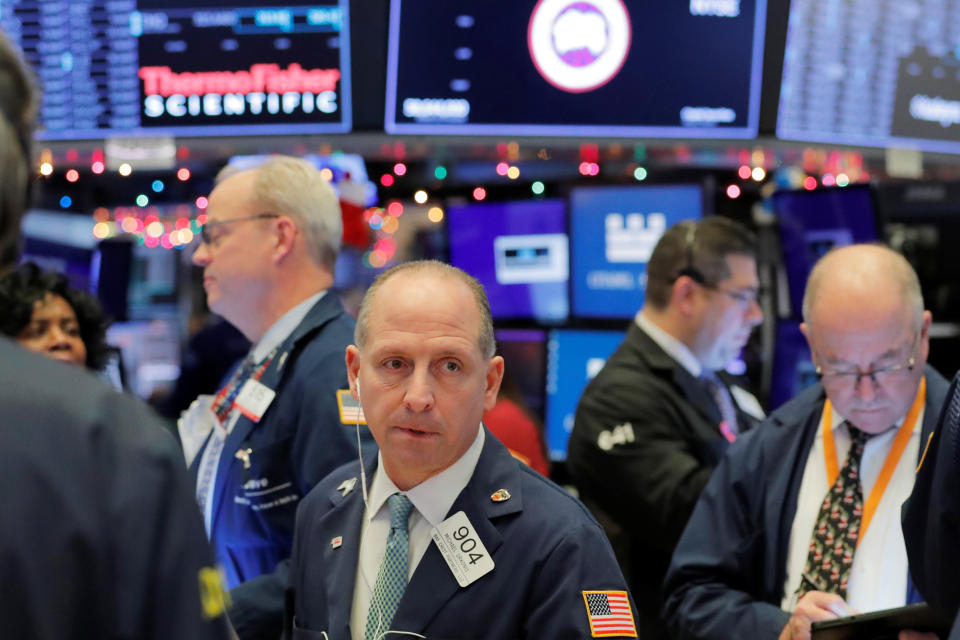Stock market news: December 6, 2019
Stocks jumped Friday after the Labor Department’s November jobs report handily topped expectations. Treasury yields rose and gold prices sharply declined, as the latest sign of strength in the U.S. economy spurred risk-on trades.
The S&P 500 reversed weekly loses on Friday to end the week 0.16% higher. The Dow and the Nasdaq pared some weekly losses, but still ended marginally lower on the week.
Here’s where markets settled at the end of regular equity trading:
S&P 500 (^GSPC): +0.91%, or 28.48 points
Dow (^DJI): +1.22%, or 337.27 points
Nasdaq (^IXIC): +1.00%, or 85.83 points
10-year Treasury yield (^TNX): +4.5 bps to 1.84%
Gold (GC=F): -1.27% to $1,464.20 per ounce
The financial sector was one of the leaders in the S&P 500, after the strong print on the labor market suggested the Federal Reserve would likely keep interest rates on hold. Shares of JPMorgan (JPM), which is also a member of the Dow, surged to an all-time high. Other Dow components including Apple (AAPL) and Nike (NKE) also hit record intraday highs.
The energy sector surged and crude oil prices spiked after OPEC and its allies agreed to reduce oil production by an additional 500,000 barrels per day (b/d) next year, bringing total output reduction to 1.7 million b/d.
The Labor Department’s “official” report on the health of the U.S. job market, released at 8:30 a.m. ET, reflected surging employment gains and a joblessness rate at a 50-year low.
Non-farm payrolls rose by a much better-than-expected 266,000 during the month. This was well above the 180,000 consensus, which had already been one of the strongest expectations of the year heading into a jobs report.
“This is a blowout number and the U.S. economy continues to be all about the jobs,” Tony Bedikian, head of global markets for Citizens Bank, said in an email. “Business owners may be getting more cautious due to trade and political uncertainty and growth may be slow, but consumers keep spending and the punch bowl still seems full.”

The results got a bump from the return of striking General Motors (GM) workers, which had created a net drag of 43,000 manufacturing jobs in October. Manufacturing payrolls rose by 54,000 in November, ahead of the 40,000 increase expected.
Meanwhile, the unemployment rate edged down to 3.5%, matching September’s rate to mark the lowest level since 1969. Average hourly earnings slipped slightly month on month to a 0.2% increase. And average hourly wages edged down to a 3.1% year on year, from 3.2% in October.
Heading into the November jobs report, other surveys capturing employment trends were mostly positive. The Institute for Supply Management’s November non-manufacturing employment index rose during the month, and weekly unemployment claims remained at relatively low levels. And economists had mostly shrugged off ADP/Moody’s most recent monthly print on private payrolls growth, which missed expectations.
Friday’s report serves as one of the last pieces of new data members of the Federal Reserve receive ahead of their December meeting. Market participants widely expect that central bankers will hold interest rates steady after three cuts earlier this year, as economic data firmed.
“Today’s jobs read puts a lot of questions to rest—it essentially means the Fed’s easing cycle is complete and it puts the US in a stronger position for trade war negotiations,” Mike Loewengart, vice president of investment strategy for E-Trade Financial, said Friday.
Later during Friday’s session, the University of Michigan released its closely monitored consumer sentiment survey for December, which also topped expectations.
The preliminary monthly headline consumer confidence index rose to 99.2 in December from 96.7 in November, coming in ahead of estimates for 97.0. The sentiment index has averaged 97.0 over the past three years, “the highest sustained level since the all-time record in the Clinton administration, Richard Curtin, surveys of consumers chief economist, said in a statement.
Curtin said the early December gain was mostly driven by more optimism among upper income households, which reported “near record gains in household wealth” due to increasing stock prices.
—
Emily McCormick is a reporter for Yahoo Finance. Follow her on Twitter: @emily_mcck
Read more from Emily:
Stock Market 2020: BMO’s bull is reminded of Notorious B.I.G., Tupac and Snoop
How this CBD company created a buzz by ‘kind of making fun of millennial culture’
FedEx CEO: ‘Whistling past the graveyard’ on the U.S. consumer belies a broader slowdown
Follow Yahoo Finance on Twitter, Facebook, Instagram, Flipboard, LinkedIn, and reddit.
Find live stock market quotes and the latest business and finance news
